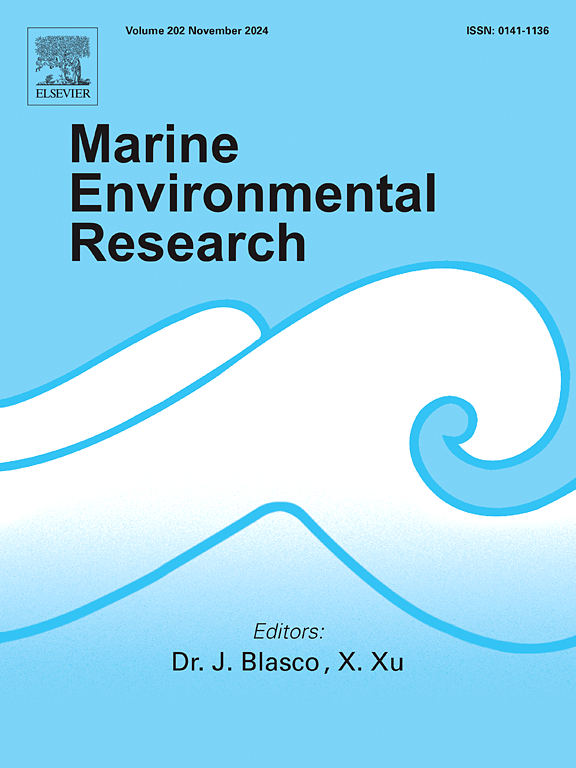大西洋两个截然不同的生态系统之间的原位塑料碎片
IF 3
3区 环境科学与生态学
Q2 ENVIRONMENTAL SCIENCES
引用次数: 0
摘要
在大西洋两个截然不同的沿海环境中,研究了传统(低密度聚乙烯,LDPE)和可生物降解塑料聚合物(聚己二酸丁二酯-对苯二甲酸酯,PBSeT)的机械破碎情况:巴西赤道亚马逊海岸和西班牙加利西亚温带海岸。实验包括在海洋环境的自然条件下,在两个不同的深度,接近底部和地下,将这两种聚合物就地暴露。纤维素条作为阳性对照。我们的研究结果表明,PBSeT和纤维素的降解速度比LDPE快,亚马逊海岸PBSeT在90天内完全破碎,西班牙海岸PBSeT在120天内完全破碎,两个地点的纤维素在60天内完全分解。LDPE在两种环境中都表现出最小的碎片化。较高的水温、湍流、大潮汐等流体动力学特征以及亚马逊地区加速的殖民化可能加速了碎片化。这些发现强调了塑料碎片在不同环境中的可变性,以及未来研究的必要性,以了解造成这种变化的主要环境变量。本文章由计算机程序翻译,如有差异,请以英文原文为准。

In situ plastic fragmentation between two contrasting ecosystems in the Atlantic
The mechanical fragmentation of a conventional (low-density polyethylene, LDPE) and a biodegradable plastic polymer (polybutylene sebacate-co-terephthalate, PBSeT) was investigated in two contrasting coastal environments in the Atlantic: The Equatorial Brazilian Amazon coast and the Spanish temperate coast of Galicia. The experiment consisted of in situ exposition of the two polymers to natural conditions in the marine environment and in two distinct depths, near the bottom and at the subsurface. Cellulose strips were used as positive control. Our results showed that PBSeT and cellulose degraded faster than LDPE, with complete fragmentation of PBSeT occurring in 90 days in the Amazon coast and 120 days in the Spanish coast, with complete cellulose disintegration before 60 days for both the locations. LDPE showed minimal fragmentation in both environments. Higher water temperatures, turbulence, hydrodynamic features such as the macrotidal regime and accelerated colonization in the Amazon likely accelerated fragmentation. These findings highlight the variability in plastic fragmentation in different environments and the need of future research to understand the main environmental variables responsible for such variation.
求助全文
通过发布文献求助,成功后即可免费获取论文全文。
去求助
来源期刊

Marine environmental research
环境科学-毒理学
CiteScore
5.90
自引率
3.00%
发文量
217
审稿时长
46 days
期刊介绍:
Marine Environmental Research publishes original research papers on chemical, physical, and biological interactions in the oceans and coastal waters. The journal serves as a forum for new information on biology, chemistry, and toxicology and syntheses that advance understanding of marine environmental processes.
Submission of multidisciplinary studies is encouraged. Studies that utilize experimental approaches to clarify the roles of anthropogenic and natural causes of changes in marine ecosystems are especially welcome, as are those studies that represent new developments of a theoretical or conceptual aspect of marine science. All papers published in this journal are reviewed by qualified peers prior to acceptance and publication. Examples of topics considered to be appropriate for the journal include, but are not limited to, the following:
– The extent, persistence, and consequences of change and the recovery from such change in natural marine systems
– The biochemical, physiological, and ecological consequences of contaminants to marine organisms and ecosystems
– The biogeochemistry of naturally occurring and anthropogenic substances
– Models that describe and predict the above processes
– Monitoring studies, to the extent that their results provide new information on functional processes
– Methodological papers describing improved quantitative techniques for the marine sciences.
 求助内容:
求助内容: 应助结果提醒方式:
应助结果提醒方式:


